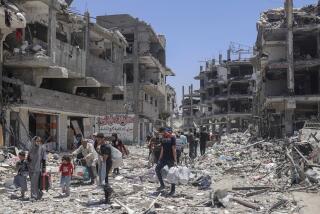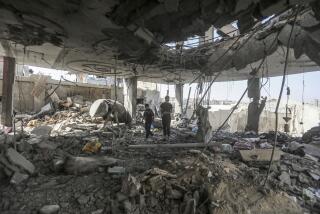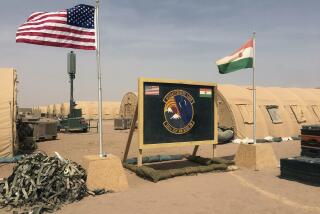Cuba, Angola and S. Africa OK Plan to Restore Namibia Peace
WINDHOEK, Namibia — Cuba, Angola and South Africa, architects of southwest Africa’s peace accord, agreed Sunday on a six- to 12-day process to end pitched battles in northern Namibia by allowing guerrillas safe passage to 18 U.N. assembly points, where they will lay down their weapons and be transported back across the border to Angola.
The agreement, coming on the heels of rebel leader Sam Nujoma’s appeal Saturday night for his forces to halt the fighting, paved the way for an end to the nine-day invasion that has claimed the lives of 263 rebels and 27 police officers. It also appeared to put the U.N.-monitored plan for Namibia’s independence, in jeopardy since the April 1 rebel incursion, back on track.
“Today is the first day we can say there is a good and realistic prospect that it (the U.N. plan) will be implemented,” Roelof F. (Pik) Botha, South Africa’s foreign minister, said Sunday night.
“Eight very difficult days are behind us,” Botha told a news conference. “I hope and pray we will all be able to proceed so this country can at last make a free and voluntary choice about its future.”
Meanwhile, clashes in northern Namibia eased Sunday, and only one SWAPO death was reported, police said.
Two Days of Talks
The plan to restore peace in Namibia was reached at a game lodge north of Windhoek during two days of emergency, high-level talks among the three countries. It calls on South Africa’s administrator in the territory and the U.N. Transitional Assistance Group to oversee the departure of about 1,900 South-West Africa People’s Organization (SWAPO) insurgents.
SWAPO, which has waged a 24-year guerrilla war against South African rule here, launched a large invasion in the north only hours after the U.N. plan for Namibian independence got under way April 1.
The peace initiative will allow SWAPO fighters to gather, “with full safety,” at U.N. assembly points and churches on the border and inside Namibia this week. Details will be broadcast at hourly intervals in local languages, the U.N. announced late Sunday night. Churches, one of the primary centers for information in northern Namibia, will also spread the word.
Allowing churches to be used as gathering places for SWAPO forces was a major concession by South Africa, said Cedric Thornberry, a spokesman for U.N. representative Martti Ahtisaari.
The first official sites will hoist the U.N. flag Tuesday, but SWAPO forces may begin congregating at churches in the north today, Thornberry said.
U.N. Troops to Act as Escorts
U.N. forces will escort fighters from churches to the formal assembly points, which will be manned by U.N. peacekeeping troops and South African security forces. At U.N. gathering sites along the border, U.N. and South Africa forces will be joined by Angolan security forces. South Africa remains in administrative control of the territory, under U.N. observation, until next November’s elections.
SWAPO fighters will “lay down their weapons with” the U.N. observers, according to Sunday’s agreement. Those at assembly points inside Namibia will be transported by air to their bases north of the 16th Parallel, about 150 miles inside Angola, Namibia’s northern neighbor. Guerrillas who surrender to U.N. forces on the border will be transferred into Angola by road under U.N. supervision, according to Sunday’s agreement.
Under Namibia’s independence plan, SWAPO forces were to be confined to bases deep in Angola until mid-May, when they would be allowed to return, unarmed, to participate in Namibia’s first free and fair elections. SWAPO is considered the likely victor in those elections.
“SWAPO (rebels) will have the assurance that if they move to the assembly points, their safety will be secured,” Botha said. On Sunday, South Africa issued instructions to its troops and Namibian police to allow SWAPO free passage.
“If they do not attack (Namibian) security forces, they will not be attacked,” Botha said.
April 21 Deadline
The three countries’ agreement called for SWAPO’s departure to be completed by Friday, but the United Nations said later that the diplomats had agreed to give the insurgents at least until April 21 to surrender.
SWAPO’s exit will be verified by South Africa’s administrator and the U.N. secretary general’s special representative. South Africa’s 1,500 troops, deployed with U.N. permission last week to quell the fighting, will return to bases after the SWAPO withdrawal is complete, Botha said.
“We are not going to accept anyone’s word on this,” Botha said. “This (departure) will have to be verified properly.”
The three countries appealed to the United Nations to “urgently adopt all necessary measures” to quickly deploy its peacekeeping forces. Only about 1,000 of the 4,650 U.N. troops that are to monitor Namibia’s independence plan have thus far arrived in the territory, although 800 more are expected by today.
The plan for SWAPO’s withdrawal closely follows the Saturday night plea by Nujoma, the SWAPO leader. In a statement issued from his exile headquarters in Luanda, Angola, Nujoma called on his forces to stop the fighting, regroup and report to U.N. forces for escort back into Angola.
Pressure on Nujoma
Nujoma had previously insisted that his rebels were not violating the Namibian independence plan, to which he had subscribed in a letter to the United Nations earlier this year. But Nujoma’s claims were refuted by the United Nations, the U.S. State Department and other countries that were surprised and angered by his decision to order his troops into Namibia as the peace process was just beginning.
Western diplomats have suggested that Nujoma ordered the invasion as a show of strength to his supporters in northern Namibia. Captured rebels confirmed that Nujoma’s military commanders told the insurgents, who were ordered to establish military bases in the territory, that they should expect no resistance from South Africa, whose troops were confined to bases under the agreement.
In asking his fighters to return to Angola, Nujoma said that SWAPO and the Namibian people “have nothing to gain by further loss of lives and the collapse of the U.N. independence plan for our country.”
Botha said Nujoma’s appeal indicated that the SWAPO leader had “come to his senses.”
“It was a gross, sad, tragic--but unforgivable--miscalculation by SWAPO,” Botha said. “And Nujoma started to discover that just about no single government or leader in the world” was supporting his actions.
4,000 Rebels
South Africa has estimated that as many as 4,000 SWAPO troops remain below the 16th Parallel, in violation of the peace agreements that opened the way for implementation of an 11-year-old U.N. resolution for Namibia’s independence. Botha said Angola and Cuba had “done their best” to monitor SWAPO’s compliance with the accord, and he described those countries’ diplomats as being “very, very badly embarrassed, to say the least,” by SWAPO’s invasion.
Angola, Cuba and South Africa had signed a U.S.-mediated peace accord in December that called on Cuba to withdraw its 50,000 troops from Angola and on South Africa to allow the United Nations to monitor free elections in Namibia. Representatives of the three countries, along with U.S. Assistant Secretary of State Chester A. Crocker and Soviet Deputy Foreign Minister Anatoly Adamishin, met Saturday and Sunday at Mt. Etjo lodge, about 120 miles north of Windhoek, to draw up a plan to salvage the Namibian peace process.
Botha said the Cubans continue to withdraw their troops under the agreed timetable and are “well within their commitment.”
More to Read
Sign up for Essential California
The most important California stories and recommendations in your inbox every morning.
You may occasionally receive promotional content from the Los Angeles Times.











